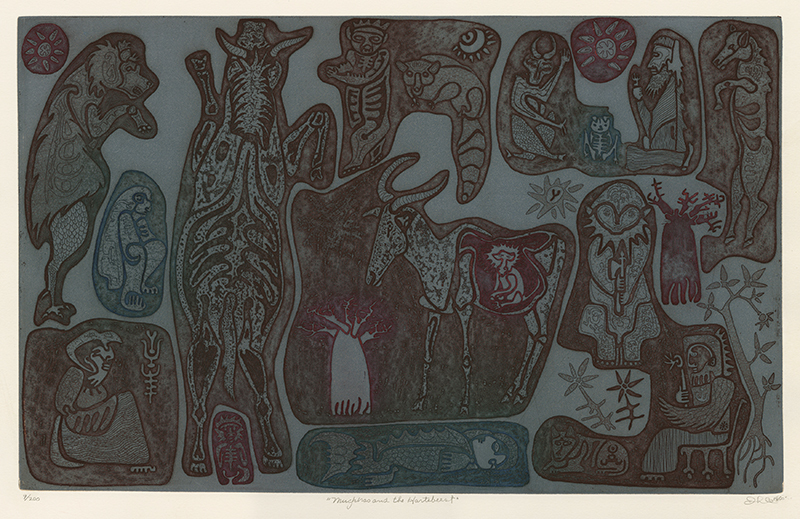
19th, 20th & 21st Century Fine Prints
707-546-7352 · fax 707-546-7924 · web: www.annexgalleries.com · email: artannex@aol.com
Mughkas and the Hartebeest by John Ihle

Mughkas and the Hartebeest
John Ihle
Mughkas and the Hartebeest
John Ihle
1925 - 2002 (biography)Ihle worked as an illustrator at the Chicago Museum of Natural History in 1950-1 where he developed his "Pictograhic Writing", evident in this print. Ihle took several of his small, pictograph-like images and exploded them to the metal plate using asphaltum and shellac in a painterly way and additional plates to add the color. Because of the experimental nature of this work impressions will vary in color from print to print, like a monoprint.
While the Mughal Empire, located primarily in South Asia, did not naturally overlap with the geographical range of hartebeest, primarily found in sub-Saharan Africa, an intriguing connection exists through this intaglio titled "Mugkhas and the Hartebeest" by American artist John Ihle.
This 1960 work, published by the International Graphic Arts Society, suggests a conceptual link between the two seemingly unrelated entities. While the exact artistic intention or narrative behind the title is not readily evident, it sparks curiosity about how the Mughal world and the African antelope might be symbolically or thematically brought together in this context.It's important to reiterate that historically, there's no evidence of direct interaction or a shared habitat between the Mughal Empire and hartebeest populations. The Mughal emperors were known to hunt and appreciate a variety of megafauna in their landscape, including lions, tigers, and cheetahs. However, historical accounts primarily focus on animals native to their region or acquired through trade within their geographical sphere of influence, such as the Asian elephant.
Therefore, the association of "Mughals and the Hartebeest" is likely a creative and artistic interpretation, open to individual interpretation and further exploration within the realm of art history and symbolism.
John Ihle studied printmaking with Francis Chapin at Wesleyan University on the G.I. bill. During the summer of 1949, he attended the University of Iowa specifically to study printmaking with Mauricio Lasansky. However, Ernest Freed, Professor at Bradley University and a Lasansky student, viewed Ihle's graduate show and offered him graduate assistance at Bradley. Ihle became Freed's graduate assistant and earned his M.A. in 1951.


